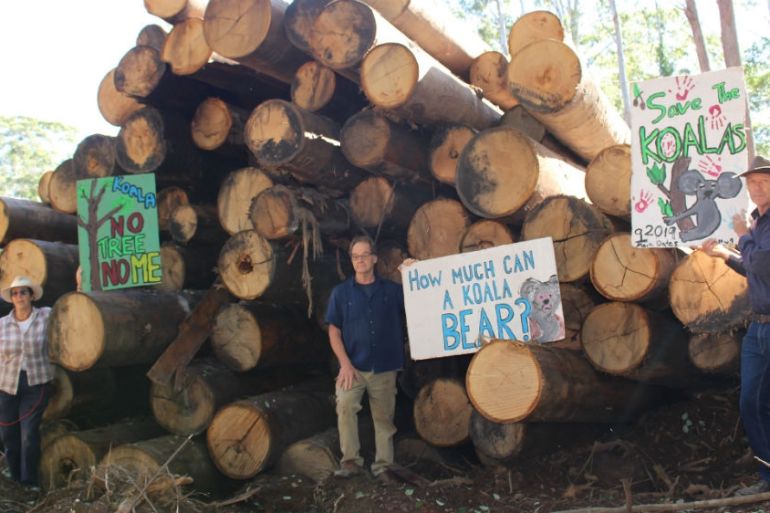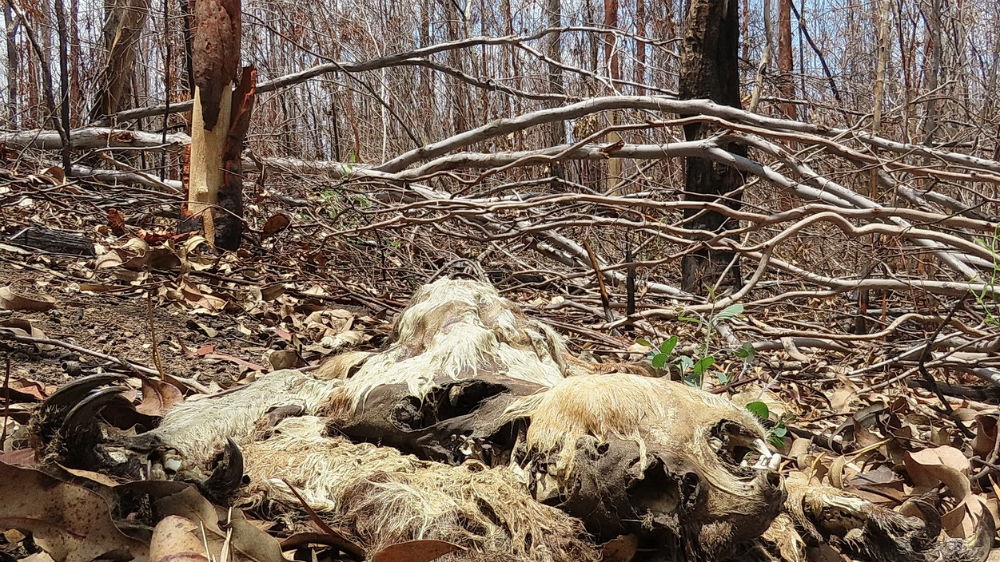Australia urged to suspend logging in wake of devastating fires
Campaigners are angry that while they are unable to protest because of the coronavirus lockdown, logging can continue.

Pressure is mounting on authorities in Australia to curb the logging of native forests in the wake of the country’s devastating southern summer bushfires.
With conservationists saying restrictions on movement because of COVID-19 are preventing protests against the resumption of logging, people have instead gone online with more than 22,000 signing a petition calling on the New South Wales (NSW) government to declare a moratorium on logging in the state’s native forests.
Keep reading
list of 3 itemsIn Pictures: Australia’s bushfires force mass exodus of people
‘A shape in the ash’: Bushfires destroy Australian wildlife
Nearly half of all “state forests” in NSW burned during the blazes that devastated parts of Australia during the country’s summer, including about 890,000 hectares (2.2 million acres) of native forest. Nationwide, more than a billion native animals were thought to have been killed in the fires, pushing many closer to extinction. As many as 8,000 koalas are estimated to have died.
Veteran forest activist Dailan Pugh was involved in what was possibly the first forest blockade in the Western world, at Terania Creek in northern NSW in 1979.
For him, the summer’s fires – including those that hit rainforest areas that do not usually burn – were devastating.
“They’re areas we fought over for a long, long time,” said Pugh, who is now in his mid-60s. “We saw them going one after another, it was horrifying and surreal.”
In early February the federal government identified 113 species nationwide hit by the fires, and recommended a halt to logging in those areas.
|
|
Despite that, logging has resumed in places considered crucial to the survival of iconic species such as the koala.
“I’m aware of a lot of people who would like to stop machinery,” Pugh said.
‘But they can’t because of COVID-19 restrictions.”
Logging deemed ‘essential’
The sentiment is common among conservationists; even those who acknowledge the need for social isolation.
“Logging has commenced again as per normal when nothing is normal in the landscape,” says Lyn Orego, a conservationist near Nambucca Heads on NSW’s northern coast.
“It is frustrating to not be able to go out like we could.”
“We are inside our homes due to the coronavirus but outside the government is continuing to authorise this destruction, subsidised by taxpayers’ money.”
In the Nambucca State Forest, largely spared this past summer’s fires, roadworks have recently begun to allow logging equipment to be brought into the forest.
“This forest is a rare patch of unburnt forest providing refuge for threatened species.”
Orego is despairing at the fate of koalas locally in light of plans to log the forest.
“The areas just aren’t there to provide the habitat,” she says.
Fellow campaigner Susie Russell said the restrictions on movement were “very problematic”.
In the Comboyne State Forest, she was part of a group able to protest and delay logging equipment in the days before lockdown measures were imposed in Australia, preventing protest. Logging, under Australia’s business-friendly social isolation measures, is allowed to continue as an “essential” economic activity.

“The government is opening up areas that were burned, logging areas that were not, all sorts of approvals which are damaging to the environment are happening during this time. We feel angry and frustrated at not being able to get out there.”
Logging contributed 9.2 billion Australian dollars ($5.9m) to the economy in 2018, with most of the timber extracted from plantation forests, according to the Department of Agriculture, Water and the Environment.
Approval granted
NSW’s Environment Protection Agency – responsible for monitoring the behaviour of loggers – lists 12 different state forests where “site-specific” approvals have been granted following the summer fires.
The agency has come under fire for reportedly approving logging operations in one area without first assessing the toll on wildlife.
When asked to respond, the agency stressed to Al Jazeera “additional site-specific conditions on the existing strict environmental controls” and highlighted “additional controls to conserve all unburnt or lightly burned areas, protect all primary koala feed trees and effectively double the amount of koala habitat that must be protected during the logging”.
Loggers cite multiple reasons for the loss of native fauna such as the koala, including habitat destruction for the expansion of human settlements.
Forestry Corporation of NSW, the state-owned forest managers responsible for logging, told Al Jazeera that “timber harvesting operations take place in less than 1 percent of state forests each year … and all harvested areas are completely regenerated”.
After the fires, it said, 70 percent of “harvesting operations” on the north coast – those near conservationists Orego and Russell – were moved to hardwood plantations.
“Timber is an essential renewable resource … and the industry is continuing to provide these products sustainably while maintaining jobs in regional areas.”
Further south, in Victoria, there is anger among conservationists that while the state has updated “logging agreements” in the wake of the country’s worst-ever fires it has not gone far enough.
The state Labor government has said it will end logging of native forests by 2030, but experts are sceptical about its reasons.

“The Victorian government has made its decision to get out of logging not because it is particularly concerned,” says Professor David Lindenmayer, an expert in post-fire regeneration at the Australian National University.
“But because there is no resource left … In the last 25 years, Victoria has lost 77 percent of its old-growth forest.”
‘Trainwreck policy’
Lindenmayer is a leading opponent of “salvage logging” after fires, the practice of removing large burned and damaged logs from fire zones, often for wood chipping.
He is sharply critical of forest management policy, and says logging “thinning” operations are worsening the intensity of fires in Victoria and driving species such as the greater glider towards extinction.
“We’ve been analysing the landscape since the [Black Saturday] fires in 2009; we’ve been looking at long-term fire history, and long-term logging history,” he said.
“In a word, it’s a train wreck.”
“We had one mega-fire before 2000 [1 million hectares burnt]. We’ve had four mega-fires since 2000.”
On Wednesday, the Victorian Supreme Court temporarily banned logging in 13 unburned forest areas, known as coupes, after activists said irreversible damage was being wrought on several endangered species as a result of the summer’s fires.
Across the state, injunctions from the court now apply to a total of 26 similar coupes, although hundreds of others are still open to logging.
Many burned areas are subject to what is known as “salvage logging”; a practice for which Lindenmayer saves some of his fiercest words.
“It’s the worst form of logging of all,” he says. “The system has burnt and is struggling to recover and you smash it again. There’s no more stupid thing you can do.”
The professor has his detractors – academics who question his methodology, in work championed by VicForests, the state-owned logging entity.
“In areas allocated for timber harvesting but that are burnt, we will harvest the equivalent of only two out of 1,000 trees that are dead or heavily burnt,” VicForests told Al Jazeera. “We will leave all unburnt trees, retain some dead trees for habitat and create corridors to connect habitat patches to the rest of the forest.”
Arguments over the science of forest management and its effect on bushfires look set to rumble on in Australia.
The rate that animals reliant on that habitat are being lost is much harder to dispute.